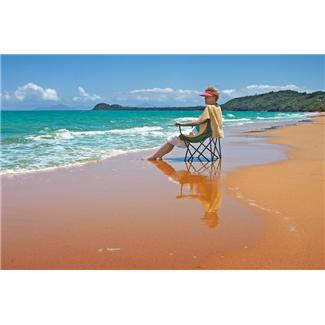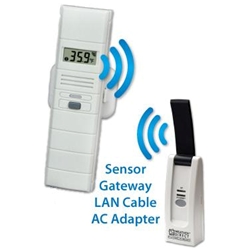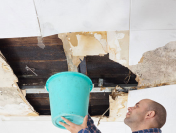For people, high humidity can be brutally uncomfortable as well as unhealthy, but it’s also a big concern for homeowners who worry about the potential damage humidity can do to the home. Â Left unchecked, high humidity in the home can ruin wood floors and furniture and encourage mold and mildew growth. Â Fortunately, there are easy ways to reduce humidity in your home plus a number of remote thermostat controls that allow you to monitor and control home humidity long distance. Â (Snowbirds with far away empty vacation homes, take note!)

What is Humidity?
The humidity we wilt from in the summertime, which is more accurately called “relative humidity” or RH, measures the amount of water vapor in the air. Warmer air can hold more water than cold air, which is why high home humidity is a bigger problem in the summer. If the humidity in your home is too high, you may notice musty smells, condensation on windows, wet stains on walls and ceilings and mold in the bathrooms. Your family may also experience allergic reactions.
How to Measure Home Humidity
The best way to measure the RH in your home is with a hygrometer (a.k.a. “moisture meter” or “humidity sensor”). Mechanical hygrometers are inexpensive and can be purchased at a hardware or home supply store. Electronic hygrometers tend to cost a little more but are often more accurate.
How to Reduce Home Humidity
Air conditioning is one of the best ways to reduce home humidity. Â Running a dehumidifier is another very effective way to reduce moisture in the air, especially in hot, humid climates. In an unoccupied home, install a whole home dehumidifier to your home’s AC system or hook up a drain hose to your portable dehumidifier so the water continuously flows into a sink or other suitable drain.
Other easy ways to reduce humidity levels in your home include:
- Keeping doors and windows closed;
- Using exhaust fans in bathrooms and kitchens to move moisture to the outside (but not into the attic);
- Venting your clothes dryer to the outside;
- Increasing air circulation by opening doors to rooms and using fans;
- Covering the dirt floor of a crawlspace with a plastic moisture barrier;
- Installing a humidistat that automatically turns the air conditioner on when the humidity in a room or house reaches above 70 percent.
Monitoring and Controlling Humidity Long Distance
1) Via PC or Smartphone
To monitor and control your air conditioning (and heating) system long distance via your PC or Smartphone, all you need is an Internet-enabled thermostat with a humidity sensor like those made by Bay Controls. Bay Controls offers three BAYweb models:
 BAYweb Standard
BAYweb Standard
A basic BAYweb Internet thermostat (with humidity sensor) controls standard HVAC systems costs less than $200. It also features one dry contact input so you can add another alarm sensor to monitor conditions like smoke or flooding.
BAYweb Advanced
To control a heat pump or multi-stage HVAC system, step up to the BAYweb Advanced (with humidity sensor) that also accommodates up to three alarm sensors. Cost is an additional $25.
BAYweb Professional
The BAYweb Professional (with humidity sensor) is the same as the Advanced but also monitors indoor or outdoor temperatures and has the ability to do remote temperature control and/or temperature averaging between sensors so you can balance temperature between two zones or rooms. Price is about $300.
All three BAYweb thermostats can send email or text alerts about temperature, humidity and energy consumption – a great feature for snowbirds who want to keep tabs on an unoccupied home in a hot, humid climate far away.
 DIY Cellular Alarm for Homes
This affordable cell phone-based alert system monitors two conditions in your home and sends text message alerts to your cell phone or mobile device to warn you of a problem.  The DIY Cellular Alarm for Homes comes standard with two water sensors, but these can be replaced with a temperature sensor and a humidity sensor to monitor for high or low levels of either.  (Note that this device only monitors and alerts — it does not provide a mechanism for control.)  The DIY Cellular Alarm sells for less than $200.  Sensors are extra.
 LaCrosse Technology Online Temperature and Humidity Wireless Alert System
LaCrosse Technology Online Temperature and Humidity Wireless Alert System
For a truly inexpensive way (under $100) to be notified if the temperature or humidity in your home is outside your defined limits, the LaCrosse Technology Wireless Temperature & Humidity Sensor wirelessly transmits readings to your computer and sends alarm notifications to you via email or text message.  (Like the DIY Cellular Alarm, this device only monitors and alerts — it does not provide a mechanism for control.)
2) Via Landline Phone
A standard landline phone connection can also be used for long distance humidity and temperature control if don’t have an Internet connection or don’t want to pay to maintain one while you away.
Venstar Comfort Call Phone-Controlled Thermostat
For the convenience of controlling temperature and humidity by phone, use a Venstar Phone-Controlled Thermostat T1800 coupled with a Venstar Comfort Call Phone Thermostat Controller and Thermostat Humidity Module.  This simple, snap-in module provides humidify/dehumidify control between the thermostat and an HVAC unit equipped with a humidification/dehumidification system.
Sensaphone 400 Cottagesitter
The versatile  Sensaphone 400 Cottagesitter monitors for power failures and detects high sound levels.  It also has four external inputs that can be connected to a variety of sensors to monitor temperature, humidity, water on the floor, and much more.  When an alarm is detected, the Sensaphone 400 can notify up to four people by making voice phone calls.
Home Humidity Levels: What is Best?
For maximum comfort and to minimize moisture damage to your home, the E.P.A. recommends an indoor RH level of between 30% and 50%. The University of Minnesota has developed guidelines for the minimum recommended humidity levels for houses. Based on a 70ºF interior room temperature, engineering studies established the following guidelines:
Outside Temperature        Inside Humidity
20º to 40º F                                  Not over 40%
0º to 20º F                                     Not over 35%
0º to 10º F                                     Not over 30%
-10º to  0º F                                  Not over 25%
-20º to –10º F                               Not over 20%
0º F or below                                Not over 15%
Note that home humidity levels are affected by the season and outdoor temperature. Low humidity in the winter can also cause health problems and damage homes, so it’s important to monitor home humidity year-round, which is easy to do with remote thermostat control.



